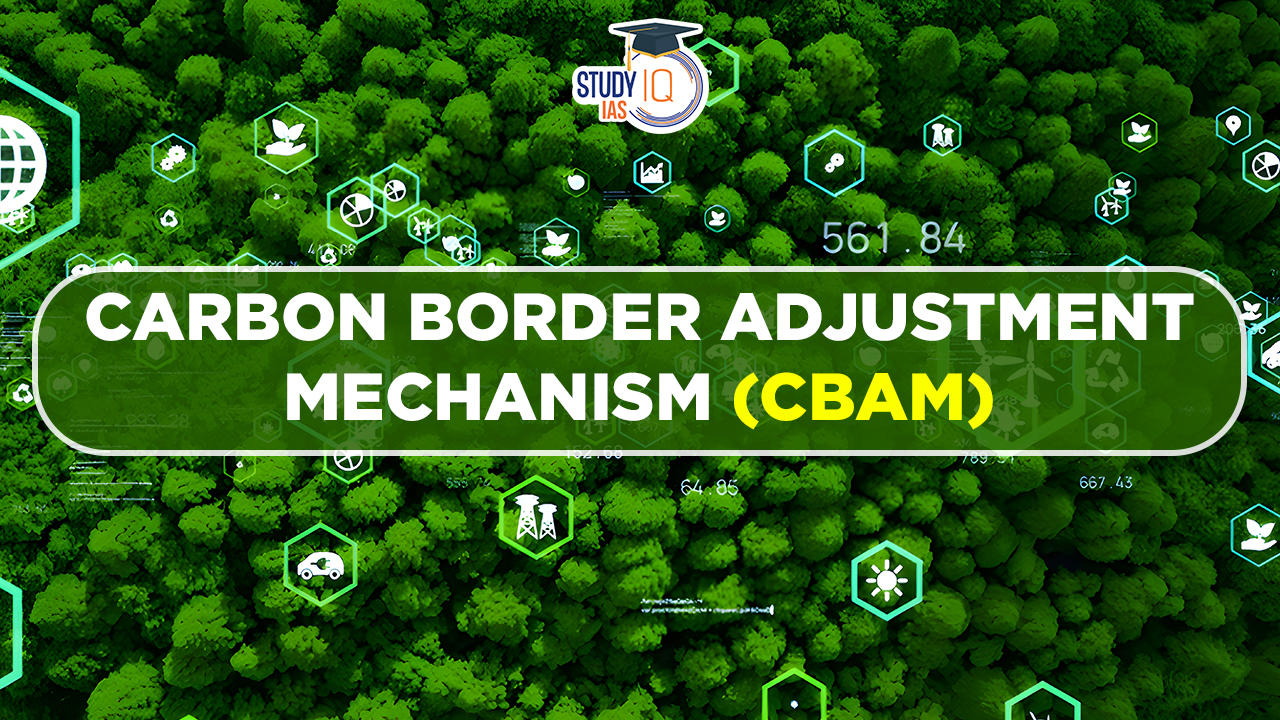Table of Contents
Context: The Commerce Ministry is exploring various options to cope with the European Union (EU)’s carbon tax proposed on Indian steel, aluminium and fertilizer exported to the trading bloc under its Carbon Border Adjustment Mechanism (CBAM) that is due to kick in from October. The levy is proposed to come into effect from January 2026.
More on the News
- The Centre had so far looked at multiple ways to tackle the EU plan, arguing that CBAM is not compatible with WTO rules and also violates the UN Framework Convention on Climate Change (UNFCCC) principle of common but differentiated responsibilities.
- CBAM is expected to deal a blow to Indian steel and aluminium companies, which are exporting to the region.
What is the EU’s Carbon Border Adjustment Mechanism (CBAM)?
- It is a proposed policy that would place a price on the carbon content of certain imported goods.
- It’s a type of carbon pricing mechanism designed to prevent carbon leakage, which occurs when companies move their operations to countries with weaker climate policies in order to avoid carbon pricing or other climate regulations.
- Under the CBAM proposal, importers of certain goods into the EU would be required to purchase emissions allowances at the same cost as EU companies under the EU Emissions Trading System (EU ETS).
- It ensures an equivalent carbon price for domestic and imported production on selected goods. This way, it would also encourage trading partners to reduce their emissions.
- CBAM was legislated as part of the European Green Deal, it takes effect in 2026, with reporting starting in 2023
- The European Green Deal, approved in 2020, is a set of policy initiatives by the European Commission with the overarching aim of making the EU climate neutral in 2050.
About the EU Emissions Trading System (EU ETS)
- It is a carbon market based on a system of cap-and-trade of emission allowances for energy-intensive industries and the power generation sector.
- It is the EU’s main tool in addressing emissions reductions.
- Since its introduction in 2005, the EU’s emissions have decreased by 41%.
How will the CBAM work in practice?
- Companies that want to import goods produced outside the EU into the EU will have to purchase certificates corresponding to the amount of emissions generated in the production of those goods.
- The European Commission will calculate the price of CBAM certificates to reflect the average weekly price of ETS auctions.
- This means that CBAM certificates will be pegged to the ETS. This will ensure that the price of CBAM certificates is as close as possible to the price of ETS allowances while also ensuring that the system remains manageable for the administrative authorities.

Which sectors and emissions are covered by CBAM?
- Initially, CBAM will cover direct emissions (scope 1) of selected sectors: iron and steel, cement, aluminium, fertilizers and electricity.
- The greenhouse gas emissions regulated by the CBAM correspond to those emissions covered by Annex I to the EU ETS, namely carbon dioxide (CO2) as well as, where relevant, nitrous oxide (N2O) and perfluorocarbons (PFCs).
- Indirect emissions (scope 2) will not be covered in the initial phase but can be added after the transitional period.
Significance of Carbon Border Adjustment Mechanism (CBAM)
- Achieving Europe’s climate ambitions: CBAM would operate alongside the other policy tools in the ‘Fit for 55’ package.
- Fit for 55 refers to the EU’s target of reducing net greenhouse gas emissions by at least 55% by 2030.
- Generating revenue: The CBAM would generate revenue for the EU, as importers of certain goods would be required to purchase emissions allowances at the same cost as EU ETS.
- Level playing field: The CBAM would create a level playing field for EU companies that are subject to carbon pricing. By placing a price on the carbon content of imported goods, the CBAM would prevent non-EU companies from gaining a competitive advantage by avoiding carbon pricing or other climate regulations.
- Encouraging global action on climate change: The CBAM is expected to encourage non-EU countries to adopt stronger climate policies, as they would face a price on their carbon-intensive exports to the EU.
Challenges associated with the Carbon Border Adjustment Mechanism (CBAM)
- Complexity: The CBAM is a complex policy proposal that involves assessing the carbon content of imported goods, issuing certificates, and ensuring compliance with reporting and payment requirements.
- Trade disputes: The CBAM is likely to face opposition from non-EU countries, who may view the policy as a form of protectionism.
- Complexity of calculating carbon content: It could be challenging to calculate the carbon content of certain products, especially if the production process involves multiple stages or takes place in countries with weaker climate policies.
- Double carbon pricing: There is a risk of double carbon pricing, where companies would be subject to carbon pricing both in the EU and in their home country. This could lead to increased costs for businesses and could undermine the effectiveness of the CBAM.
Why is CBAM a cause of concern for India?
- India is Europe’s third-largest trading partner, and it does not have its own carbon tax or cap. So, CABAM is a cause of concern for India.
- A UNCTAD study predicts that India will lose $ 1-1.7 billion in exports of energy-intensive products such as steel and aluminium.
What are the other Carbon Pricing Mechanisms available?



 Current Affairs 30th April 2024 for UPSC...
Current Affairs 30th April 2024 for UPSC...
 Editorial of the day (30th Apr): Reforms...
Editorial of the day (30th Apr): Reforms...
 Unclassed Forests, State Expert Committe...
Unclassed Forests, State Expert Committe...

















